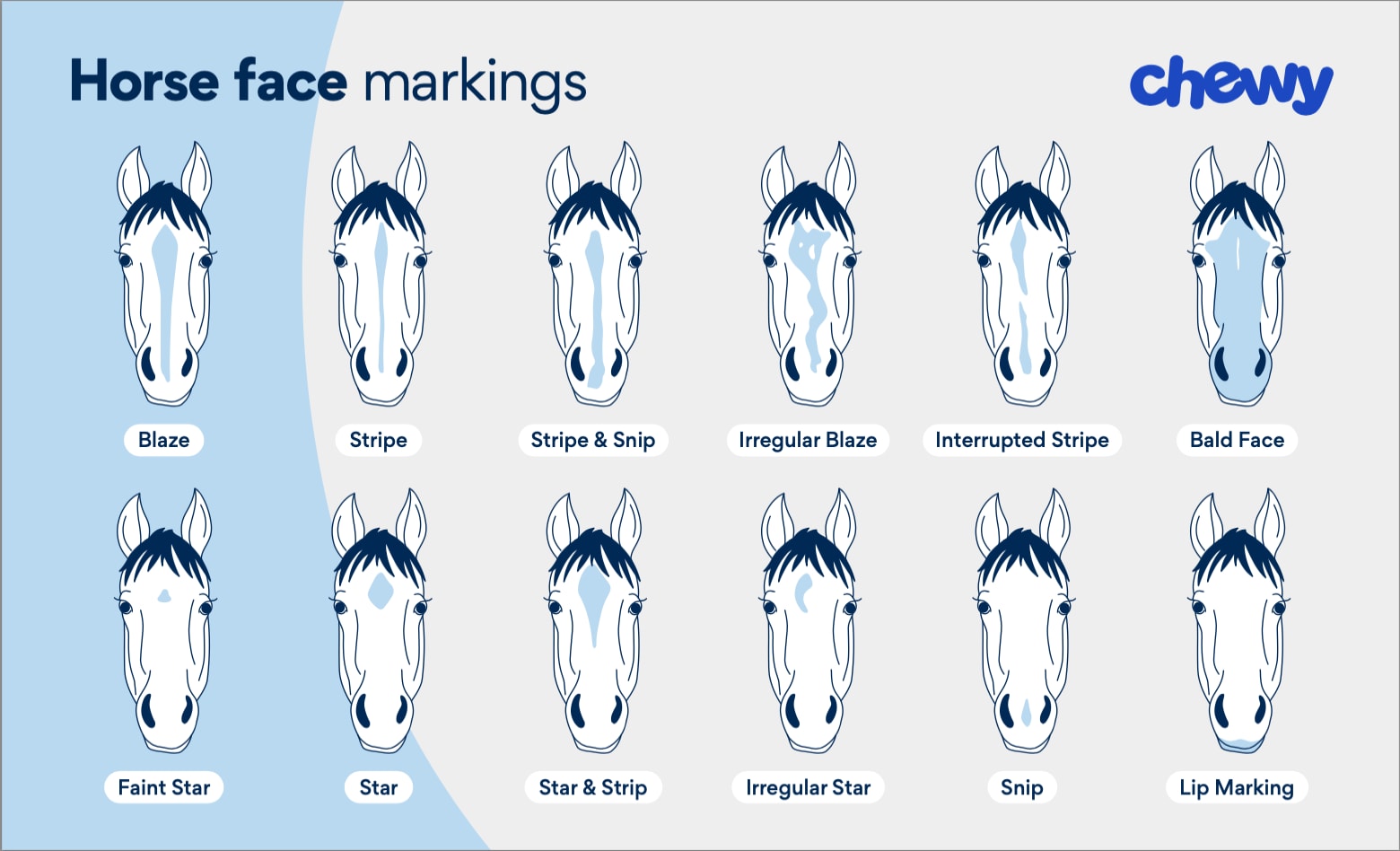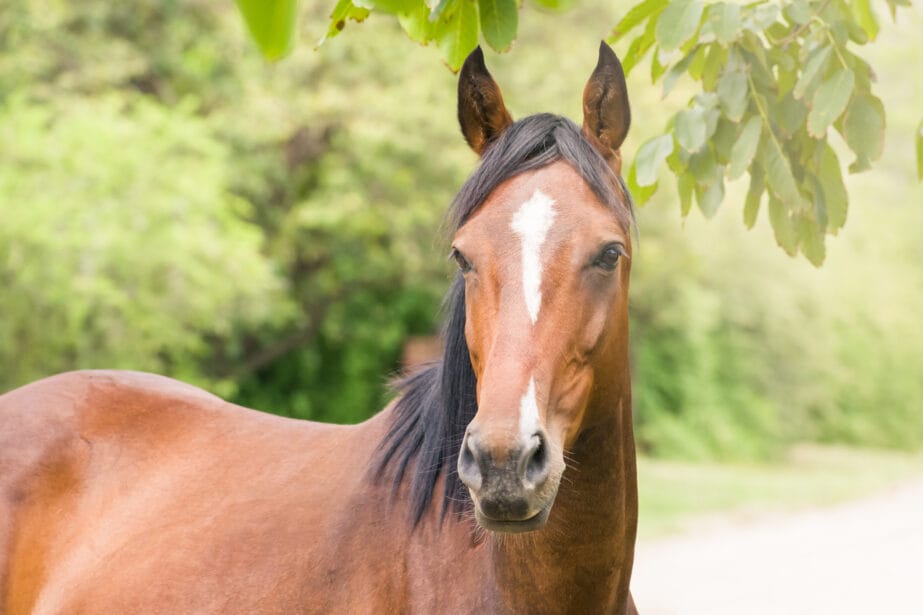Face markings are among the first things most people notice about a horse. All horse face markings are caused by the absence of melanocytes (cells that produce pigment) in the skin and hair. From a genetic perspective, there’s not much difference between a star and a blaze—both markings are simply areas of depigmentation on a horse’s face.
For horse owners, however, naming and describing horses’ face markings can be useful. Face markings can identify a lost horse, help resolve a dispute about a horse’s identity, affect the horse’s value, and add a sense of character and personality to a horse’s face.
Different Face Markings on a Horse

Blaze
A splash of white down the center of a horse’s face is called a blaze. If you dipped a paintbrush in white paint and dragged it in a single stroke from a horse’s forehead to just above their upper lip, you’d draw a perfect blaze.
These markings can appear in horses of nearly any breed, but some breed registries do not permit blazes. For example, Friesian horses with blazes cannot enter the breed’s main studbook.
Stripe
Like blazes, stripes are vertical face markings extending down the midline of the horse’s face. However, a stripe is typically narrower than a blaze and appears only on the bridge of the nose, rather than starting between the eyes and ending between the nostrils.
Stripes are often seen alongside other markings, with many horses having either a star and stripe or a star, stripe, and snip.
Irregular Blaze
An irregular blaze is exactly what it sounds like: a face marking similar to a blaze, but with asymmetrical or jagged borders. Irregular blazes are often shaped like question marks or may look like someone has erased a chunk of the horse’s blaze.
This horse face marking may be seen in almost any horse breed, but irregular blazes are more common in breeds that come in pinto colors.
Interrupted Stripe
An interrupted stripe is a narrow white face marking, like a strip, that is broken up by one or more patches of the horse’s base coat color. This marking often starts just below the eyes and is interrupted on the bridge of the nose, just above the nostrils.
Like the strip, an interrupted stripe may be combined with a star and/or snip.
Bald Face
Horses with bald face markings aren’t missing any hair on their face, as the name might suggest! Instead, they have extensive white face markings that extend over their eyes and/or nostrils. Often the whole face, aside from the ears, is white.
In breeds at risk of overo lethal white syndrome (OLWS), horses with white faces should be tested for the OLWS gene before breeding. If two horses are bred and both have the OLWS gene, it is possible the baby will have lethal white syndrome. This syndrome currently has no treatment and euthanasia is recommended.
Some breed registries, including the Rocky Mountain Horse Association, will not register horses with bald face markings, according to their current breed standards.
Star
Any white spot on a horse’s forehead between the eyes is called a star. These horse face markings are either roughly circular or diamond-shaped, but stars can occasionally appear in other shapes, such as hearts.
While many studbooks discourage extensive white face markings, small stars are typically allowed.
Faint Star
As you might have guessed from the name, a faint star is an indistinct grouping of white hairs in the center of a horse’s forehead. These minimal face markings are often seen in horse breeds where white markings are discouraged, such as in Andalusian horses.
Irregular Star
An irregular star is any white marking on a horse’s forehead that doesn’t make a distinct shape. Irregular stars are often crescent-shaped, but they may also appear as jagged splotches or short, squiggly lines between the eyes.
Snip
A white mark between a horse’s nostrils is called a snip, which frequently appears alongside stars and/or stripes. However, many horses have no white on their faces other than a small snip.
A snip positioned low on the muzzle may appear to be pink (rather than white) because the underlying pink skin is showing through the horse’s soft peach fuzz hair.
Consider applying sunscreen to any white markings on your horse’s face where pink skin is present, especially when they go outside for turnout.
Lip Marking
Any splotch of white covering all or part of a horse’s lips is simply described as a lip marking or lip spot.
Lip markings are also frequently associated with sabino and tobiano coat patterns.
How To Make Your Horse’s Face Marking Pop
If your horse has a striking white face marking, you may want to brighten and emphasize it, especially if you’ll be competing in a horse show or riding in a parade.
Fortunately, unlike white patches on the body, horse face markings rarely become stained enough to require aggressive whitening products. A gentle, regular grooming and bathing routine is all you need for at-home care.
For special events, or to even give as a gift to a horsey friend, consider adding some (or all!) of the following products:
- UV-protective fly mask: Most fly masks offer at least some UV protection, which helps avoid sun-bleaching of the base color around a white marking. The darker your horse’s base color is, the more their white markings will stand out. This fly mask from Rambo® is well-tolerated by many horses thanks to the unique shape that keeps the mesh away from your horse’s eyes.
- Soft face brush: Frequent grooming is the best way to remove dust, dirt, and flaky dry skin from your horse’s face marking. Using a soft brush designed for the face will help your horse enjoy this part of their spa routine. Many horses become so relaxed they doze off when their faces are gently brushed with extra-soft bristles!
- Hi-shine shampoo: Shapley’s™ is a favorite brand of professional horse grooms. Diluted in water, this shampoo is gentle enough for horses’ faces. (Take care not to get this—or any other—shampoo in your horse’s eyes.)
- Whitening shampoo: These soaps are specifically designed to help whiten and brighten any markings.
- Bath in a bottle: Spray-on coat conditioners can remove stains and add shine, but they should be used with caution near the eyes. Apply the product with a brush or towel, rather than spraying it directly onto the horse’s face.
Share:














